(完整)仁爱版七年级英语上册教案全集
- 格式:doc
- 大小:653.02 KB
- 文档页数:23
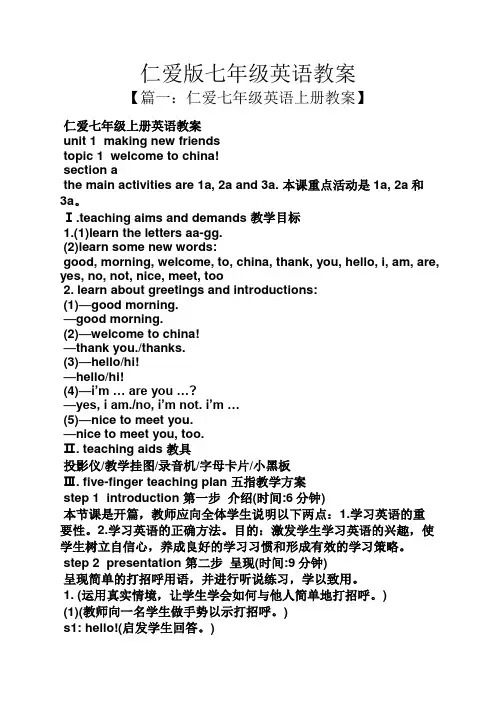
仁爱版七年级英语教案【篇一:仁爱七年级英语上册教案】仁爱七年级上册英语教案unit 1 making new friendstopic 1 welcome to china!section athe main activities are 1a, 2a and 3a. 本课重点活动是1a, 2a和3a。
Ⅰ.teaching aims and demands 教学目标1.(1)learn the letters aa-gg.(2)learn some new words:good, morning, welcome, to, china, thank, you, hello, i, am, are, yes, no, not, nice, meet, too2. learn about greetings and introductions:(1)—good morning.—good morning.(2)—welcome to china!—thank you./thanks.(3)—hello/hi!—hello/hi!(4)—i’m … are you …?—yes, i am./no, i’m not. i’m …(5)—nice to meet you.—nice to meet you, too.Ⅱ. teaching aids 教具投影仪/教学挂图/录音机/字母卡片/小黑板Ⅲ. five-finger teaching plan 五指教学方案step 1 introduction 第一步介绍(时间:6分钟)本节课是开篇,教师应向全体学生说明以下两点:1.学习英语的重要性。
2.学习英语的正确方法。
目的:激发学生学习英语的兴趣,使学生树立自信心,养成良好的学习习惯和形成有效的学习策略。
step 2 presentation 第二步呈现(时间:9分钟)呈现简单的打招呼用语,并进行听说练习,学以致用。
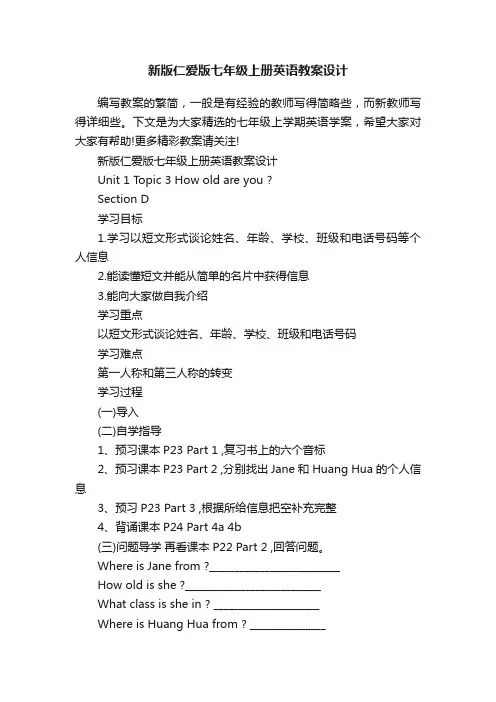
新版仁爱版七年级上册英语教案设计编写教案的繁简,一般是有经验的教师写得简略些,而新教师写得详细些。
下文是为大家精选的七年级上学期英语学案,希望大家对大家有帮助!更多精彩教案请关注!新版仁爱版七年级上册英语教案设计Unit 1 Topic 3 How old are you ?Section D学习目标1.学习以短文形式谈论姓名、年龄、学校、班级和电话号码等个人信息2.能读懂短文并能从简单的名片中获得信息3.能向大家做自我介绍学习重点以短文形式谈论姓名、年龄、学校、班级和电话号码学习难点第一人称和第三人称的转变学习过程(一)导入(二)自学指导1、预习课本P23 Part 1 ,复习书上的六个音标2、预习课本P23 Part 2 ,分别找出Jane 和 Huang Hua 的个人信息3、预习P23 Part 3 ,根据所给信息把空补充完整4、背诵课本P24 Part 4a 4b(三)问题导学再看课本P22 Part 2 ,回答问题。
Where is Jane from ?__________________________How old is she ?___________________________What class is she in ? _____________________Where is Huang Hua from ? _______________What’s his English name ? _____________________Are they in the same class ? ______________(四)典题训练(五)精讲点拨1、They are not in the same class ,but they good friends.他们不在同一个班,但是他们是好朋友。
解析:same 意思是“相同的”,前面一定要用定冠词“the”,后面接单数名词。
![[英语]仁爱版七年级上英语全册教案](https://uimg.taocdn.com/d33c8828a32d7375a417803e.webp)
Unit 3 Getting TogetherTopic 1 Does he speak Chinese?Section AThe main activities are 1a and 2a. 本课重点活动是1a和2a。
Ⅰ.Teaching aims and demands 教学目标1. Learn some new words and phrases:could, tell, sure, speak, some, poor, with, help sb. with sth., problem, pet, often, want2. Learn Present Simple to do:(1)—Do you come from the U.S.A.?—No, I don’t.(2)—Do you like Chinese?—Yes, I do.3. Ask for permission and make requests:(1)—Excuse me, could you please tell me your name?—Sure.(2)—Could you help me with it?—No problem.Ⅱ. Teaching aids 教具录音机/幻灯片/教学挂图/铅笔/尺子/玩具猫/玩具狗/蒙眼布Ⅲ. Five-finger Teaching Plan 五指教学方案Step 1 Review 第一步复习(时间:10分钟)通过复习描述体貌特征导入本课新知识,培养学生口头表达能力。
1. (教师按照座位链式提问,要求学生用Yes, I do./No, I don’t.快速作答。
)(通过运用Do you have …? Yes, I do./No, I don’t.句型引出Do you have a pen pal?) T: Do you have a pen pal, S4?(板书并要求学生了解。

仁爱英语七年级上册教案Unit 1 Lesson 1Objectives:- Identify and pronounce the words for family members in English. - Learn to use the possessive form to talk about family members. - Express likes and dislikes in English.- Engage in a conversation about family and personal preferences. Materials:- Pictures of family members- Whiteboard and markers- Handouts with the conversation dialogueProcedure:1. Warm-Up:- Greet the students and ask them how they are doing.- Review some basic greetings and introductions in English.- Ask the students if they have any siblings and if they can introduce them in English.2. Presentation:a. Vocabulary:- Introduce the vocabulary for family members by showing pictures and saying the words out loud.- Repeat the words several times and have the students repeat after you.- Write the words on the whiteboard and include their pronunciation.b. Possessive Form:- Explain the concept of possessive form in English.- Provide examples of how to use the possessive form to talk about family members.- Write some examples on the whiteboard and elicit some sentences from the students.3. Practice:a. Group Activity:- Divide the students into small groups.- Distribute pictures of family members randomly to each group.- Instruct the students to use the possessive form to describe the family members in the pictures.- Give them some time to discuss and formulate sentences together. - Have each group present their sentences and pictures to the class.b. Dialogue Practice:- Handout a conversation dialogue between two friends talking about their families and personal preferences.- Read the dialogue aloud and ask the students to follow along.- Divide the students into pairs and ask them to practice the dialogue together.- Select a few pairs to perform the dialogue in front of the class. 4. Production:- In a whole-class discussion, ask students to share their favorite family member and explain why.- Encourage the use of possessive form and personal preferences in their answers.- Provide feedback and correction as necessary.5. Wrap-Up:- Summarize the lesson by reviewing the vocabulary and possessive form.- Ask the students if they have any questions or need further clarification.- Assign any necessary homework for reinforcement.Note: The titles in this lesson plan are not included, as per your request.。

新仁爱版七年级上册英语教案英语教案是七年级英语教师为了顺利而有效地开展教学活动,根据教学大纲的要求,以课时或课题为单位对教学内容、教学步骤、教学方法等进行具体的安排、设计的一种教学文书。
下面是我为大家精心整理的,仅供参考。
Unit1 Making New FriendsTopic 1 Section A一 .学习目标1.学习字母 Aa~Gg 的读音和写法2. 学习一些简单的英语交际语言:二. 学习重点:字母 Aa~Gg三 . 学习难点:单词和问候语四. 学习过程:(一)导入 (时间:10分钟)(1. 学习英语的重要性。
2. 学习英语的正确方法。
目的:激发学生学英语的兴趣,提高学习效率。
)(二)自学指导一 1.学习字母Aa~Gg。
2.每个英文字母都有印刷体和书写体,每个字母都有大写小写之分。
字母的书写,要严格要求学生用四线格写,按笔顺和规格书写。
3. 看课文会跟读课文中出现的交际用语二. 告诉学生单词是由字母组成的,而句子是由单词组成的。
你们知道在英语中问候别人时应该如何去说吗?(三) 问题导学( )1.英语字母共有个 A. 28 B. 26 ( )2.在英语书写中应用________ A 手写体 B 印刷体 ( )3 .大写字母D 的第一笔是________ A 竖 B 半圆 ( )4 .大写字母E的第一笔是_________ A 横 B 竖横- ( )5 .大写字母F 的第一笔是_________ A 横 B 竖一. 听并选出你所听到的字母A aB bC cD dE eF fG g二.(两人一组上讲台表演,进行小组竞赛,学习1a和3a。
)S1: Good morning!S2: ________________S1: Im... Are you...?S2: ___________________S1: Nice to meet you.S2: _____________________________S1: Welcome to China!S2: __________________________(四) 典题训练 ?一按顺序默写所学字母。
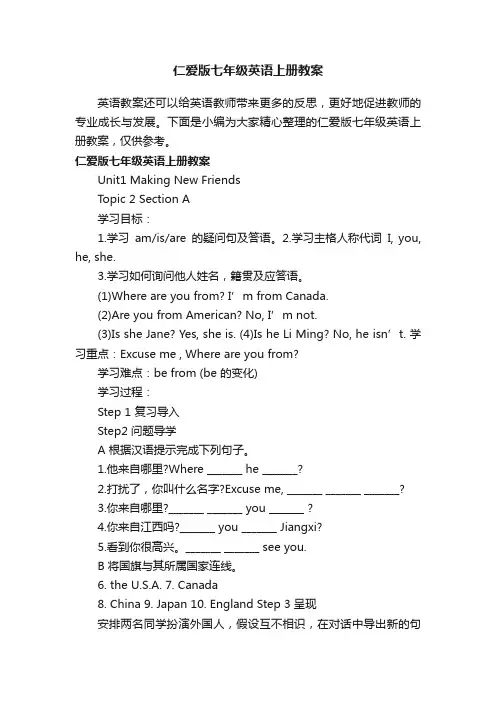
仁爱版七年级英语上册教案英语教案还可以给英语教师带来更多的反思,更好地促进教师的专业成长与发展。
下面是小编为大家精心整理的仁爱版七年级英语上册教案,仅供参考。
仁爱版七年级英语上册教案Unit1 Making New FriendsTopic 2 Section A学习目标:1.学习am/is/are的疑问句及答语。
2.学习主格人称代词I, you, he, she.3.学习如何询问他人姓名,籍贯及应答语。
(1)Where are you from? I’m from Canada.(2)Are you from American? No, I’m not.(3)Is she Jane? Yes, she is. (4)Is he Li Ming? No, he isn’t. 学习重点:Excuse me , Where are you from?学习难点:be from (be 的变化)学习过程:Step 1 复习导入Step2 问题导学A 根据汉语提示完成下列句子。
1.他来自哪里?Where _______ he _______?2.打扰了,你叫什么名字?Excuse me, _______ _______ _______?3.你来自哪里?_______ _______ you _______ ?4.你来自江西吗?_______ you _______ Jiangxi?5.看到你很高兴。
_______ _______ see you.B 将国旗与其所属国家连线。
6. the U.S.A.7. Canada8. China 9. Japan 10. England Step 3 呈现安排两名同学扮演外国人,假设互不相识,在对话中导出新的句型。
S2: Where are you from?S3: I’m from JapanS4: Oh. Are you from Canada?S5: No, I’m not. I’m from the U.S.A.Step 4. 巩固1.(看黑板上的关键词,两人一组表演1a,可换成自己的真实姓名。
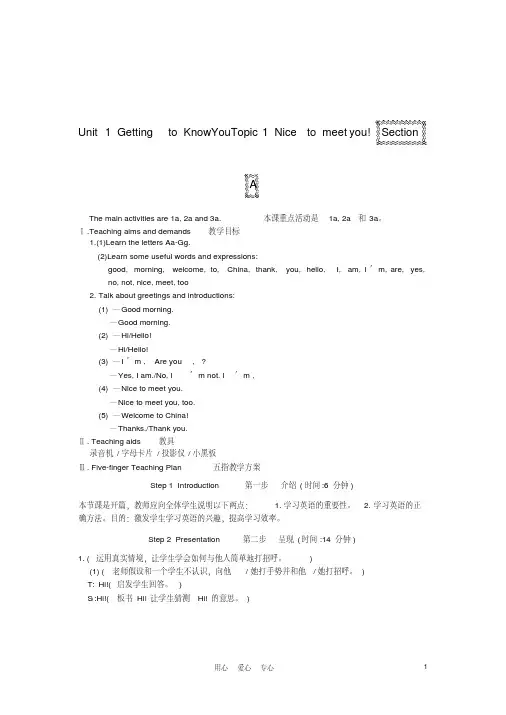
Unit 1 Getting to Know Y ouTopic 1 Nice to meet you! SectionAThe main activities are 1a, 2a and 3a. 本课重点活动是1a, 2a和3a。
Ⅰ.Teaching aims and demands 教学目标1.(1)Learn the letters Aa-Gg.(2)Learn some useful words and expressions:good, morning, welcome, to, China, thank, you, hello, I, am, I’m, are, yes, no, not, nice, meet, too2. Talk about greetings and introductions:(1)—Good morning.—Good morning.(2)—Hi/Hello!—Hi/Hello!(3)—I’m , Are you ,?—Yes, I am./No, I’m not. I’m ,(4)—Nice to meet you.—Nice to meet you, too.(5)—Welcome to China!—Thanks./Thank you.Ⅱ. Teaching aids 教具录音机/字母卡片/投影仪/小黑板Ⅲ. Five-finger Teaching Plan 五指教学方案Step 1 Introduction 第一步介绍(时间:6分钟)本节课是开篇,教师应向全体学生说明以下两点: 1.学习英语的重要性。
2.学习英语的正确方法。
目的:激发学生学习英语的兴趣,提高学习效率。
Step 2 Presentation 第二步呈现(时间:14分钟)1. (运用真实情境,让学生学会如何与他人简单地打招呼。
)(1) (老师假设和一个学生不认识,向他/她打手势并和他/她打招呼。
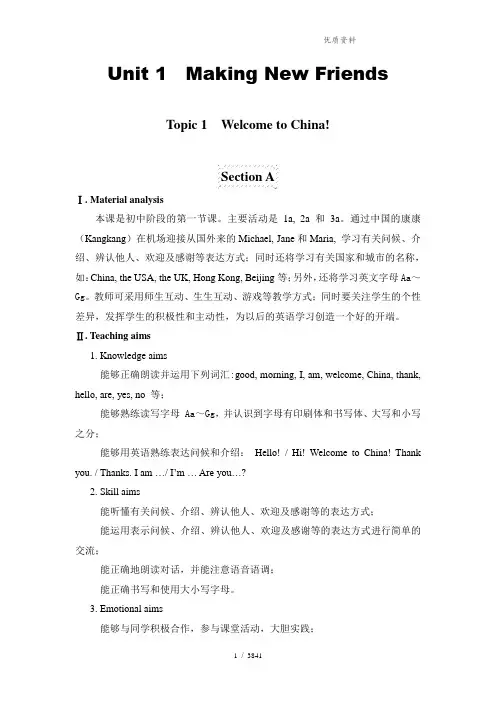
Unit 1 Making New FriendsTopic 1 Welcome to China!Section AⅠ. Material analysis本课是初中阶段的第一节课。
主要活动是1a, 2a和3a。
通过中国的康康(Kangkang)在机场迎接从国外来的Michael, Jane和Maria, 学习有关问候、介绍、辨认他人、欢迎及感谢等表达方式;同时还将学习有关国家和城市的名称,如:China, the USA, the UK, Hong Kong, Beijing等;另外,还将学习英文字母Aa~Gg。
教师可采用师生互动、生生互动、游戏等教学方式;同时要关注学生的个性差异,发挥学生的积极性和主动性,为以后的英语学习创造一个好的开端。
Ⅱ. Teaching aims1. Knowledge aims能够正确朗读并运用下列词汇:good, morning, I, am, welcome, China, thank, hello, are, yes, no 等;能够熟练读写字母 Aa~Gg,并认识到字母有印刷体和书写体、大写和小写之分;能够用英语熟练表达问候和介绍:Hello! / Hi! Welcome to China! Thank you. / Thanks. I am …/ I’m…Are you…?2. Skill aims能听懂有关问候、介绍、辨认他人、欢迎及感谢等的表达方式;能运用表示问候、介绍、辨认他人、欢迎及感谢等的表达方式进行简单的交流;能正确地朗读对话,并能注意语音语调;能正确书写和使用大小写字母。
3. Emotional aims能够与同学积极合作,参与课堂活动,大胆实践;能够认真、规范书写英文字母和单词;能够体会到英语学习的兴趣,养成良好的英语学习习惯。
Ⅲ. The key points and difficult points1. Key points正确使用表示问候、介绍、辨认他人、欢迎及感谢等的表达方法;正确书写Aa~Gg大小写字母。
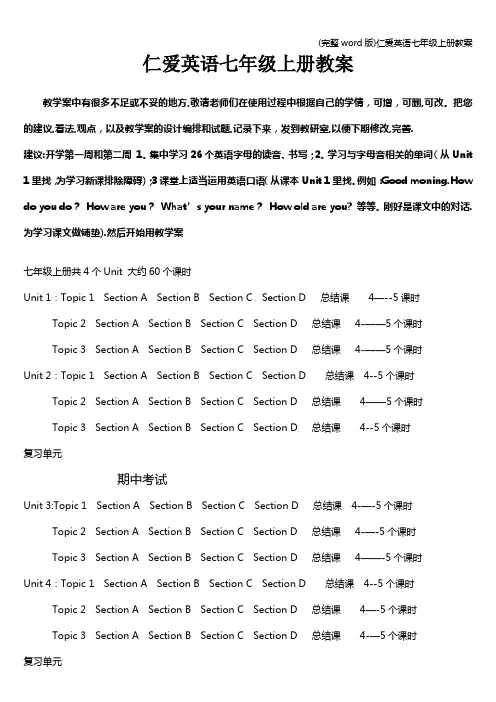
(完整word版)仁爱英语七年级上册教案仁爱英语七年级上册教案教学案中有很多不足或不妥的地方,敬请老师们在使用过程中根据自己的学情,可增,可删,可改。
把您的建议,看法,观点,以及教学案的设计编排和试题,记录下来,发到教研室,以便下期修改,完善.建议:开学第一周和第二周1。
集中学习26个英语字母的读音、书写;2。
学习与字母音相关的单词(从Unit 1里找,为学习新课排除障碍);3课堂上适当运用英语口语(从课本Unit 1里找。
例如:Good moning.How do you do?How are you?What’s your name?How old are you? 等等。
刚好是课文中的对话.为学习课文做铺垫).然后开始用教学案七年级上册共4个Unit 大约60个课时Unit 1:Topic 1 Section A Section B Section C Section D 总结课4—--5课时Topic 2 Section A Section B Section C Section D 总结课4-——5个课时Topic 3 Section A Section B Section C Section D 总结课4-——5个课时Unit 2:Topic 1 Section A Section B Section C Section D 总结课4--5个课时Topic 2 Section A Section B Section C Section D 总结课4——5个课时Topic 3 Section A Section B Section C Section D 总结课4--5个课时复习单元期中考试Unit 3:Topic 1 Section A Section B Section C Section D 总结课4-—-5个课时Topic 2 Section A Section B Section C Section D 总结课4-—-5个课时Topic 3 Section A Section B Section C Section D 总结课4——-5个课时Unit 4:Topic 1 Section A Section B Section C Section D 总结课4--5个课时Topic 2 Section A Section B Section C Section D 总结课4—-5个课时Topic 3 Section A Section B Section C Section D 总结课4-—5个课时复习单元期末考试。
![[英语]仁爱版七年级上英语全册教案](https://uimg.taocdn.com/b32a33dbba4cf7ec4afe04a1b0717fd5360cb268.webp)
[英语]仁爱版七年级上英语全册教案t:couldyoupleasetellmeyourage,s?6s:sure.i’m…6t:couldyoupleasetellmeyourtelephonenumber?s:sure.it’s…6(学生两人一组运用couldyoupleasetellme…?句型查问个人信息。
)3.t:i’manenglishteacher.icanspeakenglish.doyouspeakenglishafterclass,s?7s:yes,ido.(帮助学生回答。
)7(板书并要求学生掌握。
)speakt:doyoulikeit?(教师提示此处like作动词。
)s:yes,ido./no,idon’t.(帮助学生提问)7(学生两人一组训练,运用doyouspeak…?和doyoulike…?句型及其确实和驳斥提问。
)4.(教师恳请一个学生,用notgood去带出poor一词。
)t:isyourenglishgood?s:no,itisn’t.icanspeaksomeenglish,butmyenglishisn’t verygood.8t:youcansay“myenglishispoor.”(板书并要求学生掌握。
)somepoors:myenglishispoor.couldyouhelpme?8t:noproblem.icanhelpyouwithitaf terclass.(板书并要求学生掌握。
)noproblem.help…with…t:s,doyoulikeenglish?s:yes,ido.99t:doyouoftenspeake nglishafterclass?s:yes,ido.t:good!9(板书并建议学生掌控。
)often(通过以上的活动引入1a。
)step2presentation第二步呈现出(时间:8分钟)通过听力、教学折页等形式呈现出本课对话,使学生练采用关键句型,培育学生的听到、canada.c.china.(2)doesjanespeakenglish?a.no,shedoesn’t.b.yes,shedoes.c.wedon ’tknow.(3)whosechineseispoor?a.jane’s.b.theboy’s.c.maria’s.(核对答案。
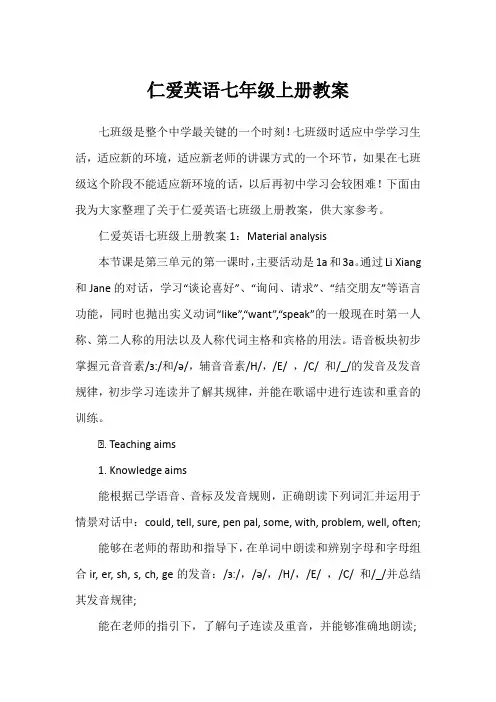
仁爱英语七年级上册教案七班级是整个中学最关键的一个时刻!七班级时适应中学学习生活,适应新的环境,适应新老师的讲课方式的一个环节,如果在七班级这个阶段不能适应新环境的话,以后再初中学习会较困难!下面由我为大家整理了关于仁爱英语七班级上册教案,供大家参考。
仁爱英语七班级上册教案1:Material analysis本节课是第三单元的第一课时,主要活动是1a和3a。
通过Li Xiang 和Jane的对话,学习“谈论喜好”、“询问、请求”、“结交朋友”等语言功能,同时也抛出实义动词“like”,“want”,“speak”的一般现在时第一人称、第二人称的用法以及人称代词主格和宾格的用法。
语音板块初步掌握元音音素/з:/和/ə/,辅音音素/H/,/E/ ,/C/ 和/_/的发音及发音规律,初步学习连读并了解其规律,并能在歌谣中进行连读和重音的训练。
Ⅱ. Teaching aims1. Knowledge aims能根据已学语音、音标及发音规则,正确朗读下列词汇并运用于情景对话中:could, tell, sure, pen pal, some, with, problem, well, often;能够在老师的帮助和指导下,在单词中朗读和辨别字母和字母组合ir, er, sh, s, ch, ge的发音:/з:/,/ə/,/H/,/E/ ,/C/ 和/_/并总结其发音规律;能在老师的指引下,了解句子连读及重音,并能够准确地朗读;能结合谈论喜好、提出请求、结交朋友的表达方式,正确使用实义动词like/speak/want一般现在时第一、第二人称单数的陈述句、一般疑问句及其肯定和否定回答;能正确使用人称代词的主格和宾格形式,如:I like it very much.Could you help me with it?能在真实的语言环境中,运用表达询问、请求和谈论喜好等交际功能的用法,与他人进行真实沟通,如:Could you tell me your name?Could you help me with it?Do you like Chinese?I want to find a pen pal.2. Skill aims能听懂有关表达询问、请求、谈论喜好的简单对话或叙述;能就表达询问、请求、谈论喜好等的话题进行沟通;能正确地朗读对话,注意重音和连读;能写出表达询问、请求和谈论喜好的简单句子或小短文。
七年级上册英语仁爱版教案教案标题:七年级上册英语仁爱版教案教案目标:1. 通过本节课的学习,学生能够掌握并正确使用本课时的重点词汇和短语。
2. 学生能够理解并运用本课时的语法知识。
3. 学生能够通过听、说、读、写的综合训练,提高英语的听说能力。
4. 学生能够通过合作学习,培养团队合作和沟通能力。
教学重点:1. 本课时的重点词汇和短语。
2. 本课时的语法知识。
3. 听、说、读、写的综合训练。
教学难点:1. 学生能够正确运用本课时的语法知识。
2. 学生能够通过合作学习,培养团队合作和沟通能力。
教学准备:1. 教材:七年级上册英语仁爱版教材。
2. 多媒体设备。
3. 学生练习册和笔。
教学过程:Step 1:导入(5分钟)引入本课时的主题,并通过图片或视频激发学生的兴趣,引发学生对新课的思考和猜测。
Step 2:新课呈现(10分钟)通过多媒体设备呈现本课时的重点词汇和短语,并帮助学生理解和记忆。
教师可以使用图片、示范动作等方式进行词汇和短语的教学。
Step 3:语法讲解(15分钟)教师通过多媒体设备讲解本课时的语法知识,并结合例句进行解释和示范。
教师可以设计一些练习题,引导学生进行语法知识的巩固和运用。
Step 4:听说训练(15分钟)教师播放相关录音材料,让学生进行听力训练,并进行相关问题的回答。
接着,教师组织学生进行口语练习,让学生运用所学知识进行对话练习。
Step 5:阅读训练(10分钟)教师分发相关阅读材料,让学生进行阅读训练,并回答相关问题。
教师可以设置一些阅读理解题目,帮助学生提高阅读理解能力。
Step 6:写作训练(10分钟)教师设计一些写作任务,让学生运用所学知识进行写作训练。
教师可以提供一些写作模板和指导,帮助学生完成写作任务。
Step 7:合作学习(10分钟)教师组织学生进行合作学习活动,让学生在小组中进行交流和合作。
教师可以设计一些合作任务,培养学生的团队合作和沟通能力。
Step 8:总结与反思(5分钟)教师对本节课的内容进行总结,并让学生进行反思和提出问题。
Unit 2 Looking DifferentTopic 1 I have a small nose.Section AThe main activities are 1a, 2a and 3a. 本课重点活动是1a, 2a和3a。
Ⅰ.Teaching aims and demands 教学目标1.Learn some useful words(1)Learn words about parts of the bodynose, eye, head, face, hair, ear, mouth, neck(2)Learn other useful wordsguess, have, small, has, big, know, right, round, long, wide, girl, boy, short2. Learn the simple present tense with“have/has”and adjectives ofdescription(1)I have a small nose.(2)They have round faces.(3)She has long hair.(4)It has big ears.3. Learn how to describe people’s appearances.Ⅱ. Teaching aids 教具小黑板/影片的封面或图片/录音机/教学挂图Ⅲ. Five-finger Teaching Plan 五指教学方案Step 1 Review 第一步复习(时间10分钟)(出示小黑板上的图画和信息,师生进行互动问答,后让学生两人一组对话表演。
复习描述人的基本情况。
)School Beijing Ren’ai International School(1)T What’s her name?S1 Her name is Jane.T How old is she?S2 She is twelve.T Where is she from?S3 She is from Canada.T What class is she in?S4 She is in Class Four, Grade Seven.T What’s her telephone number?S5It’s (010)9267-6929.(把全班学生分成两组就此对话表演。
Unit 1 Getting to Know YouTopic 1 Nice to meet you!Section AThe main activities are 1a, 2a and 3a. 本课重点活动是1a, 2a和3a。
Ⅰ.Teaching aims and demands 教学目标1.(1)Learn the letters Aa-Gg.(2)Learn some useful words and expressions:good, morning, welcome, to, China, thank, you, hello, I, am, I’m, are, yes, no, not, nice, meet, too2. Talk about greetings and introductions:(1)—Good morning.—Good morning.(2)—Hi/Hello!—Hi/Hello!(3)—I’m … Are you …?—Yes, I am./No, I’m not. I’m …(4)—Nice to meet you.—Nice to meet you, too.(5)—Welcome to China!—Thanks./Thank you.Ⅱ. Teaching aids 教具录音机/字母卡片/投影仪/小黑板Ⅲ. Five-finger Teaching Plan 五指教学方案Step 1 Introduction 第一步介绍(时间:6分钟)本节课是开篇,教师应向全体学生说明以下两点:1.学习英语的重要性。
2.学习英语的正确方法。
目的:激发学生学习英语的兴趣,提高学习效率。
Step 2 Presentation 第二步呈现(时间:14分钟)1. (运用真实情境,让学生学会如何与他人简单地打招呼。
)(1) (老师假设和一个学生不认识,向他/她打手势并和他/她打招呼。
)T: Hi!(启发学生回答。
)S1: H i!(板书Hi!让学生猜测Hi!的意思。
)(师生互动操练Hi!)T: Hi!S2: H i!(2)(用同样的方式教学Hello!并板书Hello!)—Hello! —Hi!(非正式)—Hello! —Hi!(同时老师可以利用简笔画告诉学生两个熟悉的人怎样相互打招呼。
并让学生之间用真实姓名依次操练。
)T: Please look at the picture and see how they are greeting. Then you can use your name togreet each other.S3: H i, Zhang Hua!S4: H i, Chen Jun!S3: H ello, Zhou Jie!S5: H ello, Zhang Hua!(3)(教师亲切地用手势跟同学们打招呼。
)T: Good morning!(重复几遍后,启发学生回答。
)Ss: Good morning!(板书)Good morning!(让学生猜测Good morning!的意思,教师给予提示:早上见面问好可用Good morning!代替Hello!)(师生互动操练Good morning!)T: Good morning!S4: Good morning!…(教师让学生用自己的真实姓名互动操练Hi!/Hello!/Good morning!)S5: H i! S6.S6: H i! S5.S7: H ello! S8.S8: H ello! S7.S9: G ood morning! S10.S10:Good morning! S9.…(对学生的表演给予掌声鼓励。
)2.(教师投影仪或教学挂图1a,显示康康在接机大厅接人的场景,三个外国学生刚下飞机,我们怎么向他们打招呼呢?)Ss: Hi!/Hello!/Good morning.(利用上面图片学习Welcome to …, Thank you.)T: They are our new friends. Welcome to our class.Ss: Thank you.3. (播放录音1a, 让学生跟读, 注意模仿语音语调。
)T: Listen to the tape and follow. Pay attention to the pronunciation and intonation.4. (出示四个小主人公的人物图,让学生认识他们,并教学生读Kangkang, Michael, Jane, Maria四个名字,教师播放1b录音,完成1b。
核对答案并打分。
)5. (1)(教学I’m … Are you …? Yes, I am./No, I’m not.)(教师找两名男生和两名女生分别扮演Kangkang, Michael, Jane, Maria.分别教他们说I’m Kangkang. I’m michael. I’m Jane. I’m Maria.引出I’m=I am. 再问Are you Kangkang? Yes, I am./No, I am not.)(板书)(老师向全班同学介绍自己,然后点几个学生站起来向全班同学打招呼并做自我介绍。
) T: Hi! I’m … (老师手指着自己。
)S11: H i! I’m Wu San. (S11站起来。
)S12: H i! I’m Wang Xiang. (S12站起来。
)S13: H i! I’m Wei Hua. (S13站起来。
)(老师接着对刚刚做自我介绍的学生进行提问,练习上面板书的另两个句式。
)T: I’m … Are you Wei Hua?S13: Y es, I am.(学生点头,这时老师引导学生作答。
)T: I’m … Are you Li Feng?S12: N o, I’m not. I’m Wang Xiang.(让S12和S13单独在讲台上表演,并掌声鼓励。
)(让学生两两进行类似操练。
)(2)(再找来一名学生S14,教学Nice to meet you. Nice to meet you, too.的情景用法。
(教师示范表演。
)T: Hello! I’m … Are you Liu Siyang?S14:No, I’m not. I’m Wendy.T: Oh, nice to meet you, Wendy.S14:Nice to meet you, too.(老师引导学生作答。
)(让两名学生在讲台上表演,教师给予指导。
)(让学生互相问答,借此机会运用类似的对话认识同学。
)Step 3 Consolidation 第三步巩固(时间:7分钟)1. (播放录音3a,让学生跟读,注意模仿语音语调并进行人机对话。
完成3a。
)T: Listen to the tape and repeat, pay attention to the pronunciation and intonation, please. Then practice the dialog with the tape.2. (让学生自由组合操练1a和3a,然后让学生两人一组上讲台表演。
进行小组竞赛,巩固1a和3a所学内容。
完成3b。
)T: Practice a dialog according to 1a and 3a in pairs, then act it out.S1: G ood morning!S2: G ood morning!S1: I’m … Are you …?S2: Y es, I am.S1: N ice to meet you.S2: N ice to meet you, too.S1: W elcome to China!S2: T hanks./Thank you.3. (再让学生四人一组用自己的真实姓名上台表演。
)T: Act out the dialog with your own names.S3: H i!S4: H i!S3: I’m … Are you …?S4: Y es, I am.S3: H ello! Are you …?S5: N o, I’m not. I’m …S3: N ice to meet you.S5: N ice to meet you, too.S3: H i! Are you …?S6: Y es, I am.S3: W elcome to China!S6: T hanks./Thank you.Step 4 Practice 第四步练习(时间:10分钟)1. (学习字母Aa~Gg。
)(1)(教师逐个出示字母卡片,先示范字母的读音,要求学生仔细听,认真观察教师的口型,再进行模仿。
每个字母都要用升降调来读。
)T: Listen to me and read the letters after me. Learn Aa-Gg by heart.(教师先教学字母Aa-Gg,然后全体学生跟读Aa,Bb, Cc, Dd, Ee, Ff, Gg。
) T: Aa Bb Cc Dd Ee Ff GgSs:Aa Bb Cc Dd Ee Ff Gg(2)(告诉学生,每个英文字母都有印刷体和书写体、大写小写之分。
关于字母的书写,要严格要求学生用四线格的练习本,按笔顺和格式书写。
逐个板书英文字母。
书写每个字母时,教师要做好示范,从起笔到收笔,用几笔写成的都要示范清楚。
带着学生用右食指在空中模仿,然后让学生在四线格上临摹。
完成2a。
)T: Now let’s learn how to write the letters.2. (1)(英语字母接力游戏。
)T: Now let’s play a game.(由第一排第一个同学快速说出“A”,第二个同学快速接上“B”。
依次C,D,E,F,G,A,B……)T: The first student in the first row says “A”quickly, and the second student follows “B” and then C, D, E, F, G, A, B … one by one.(待上个游戏完成后,再要求第一个同学报出“AB”,第二个同学快速接上“BC”,第三个同学快速接上“CD”……以此类推,直到全班同学都参与进去。
)T: Well done! Now the first one says “AB”, the second one follows “BC”quickly, the third one says “CD” and so on.(2)(两人一组用身体组成任何一个大写字母,并大声说出该字母。